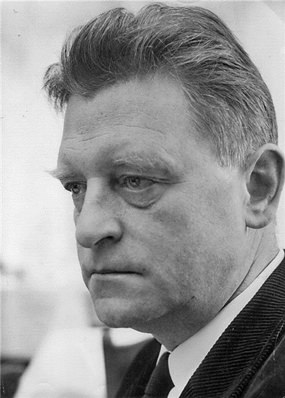It’s a well-known fact that orchestral string players tend to prefer the company of other string players and rarely mingle with the woodwind and especially not with the brass. It’s not that string players are snobs you understand, they are just different and I speak as a one-time string player myself. (The cello, since you asked.) As a result, you’ll nearly always find the happiest string players in string quartets or string orchestras where they’re not obliged to brush shoulders with those considered undesirable.
The string orchestra is popular with composers too and usually contains between twelve and twenty-four musicians. Because the numbers are relatively small and the players can actually hear each other, they often perform without a conductor.
 Dag Wirén c. 1960.
Dag Wirén c. 1960.
There’s a surprisingly large repertoire for string orchestra and some composers have written entire symphonies for strings alone. The Mendelssohn string symphonies and the Rossini string sonatas spring to mind. Some of the best-loved works in the repertoire are written just for strings. Perhaps you can recall Samuel Barber’s beautiful Adagio for Strings (originally for string quartet), Bartók’s elemental and rhythmic Divertimento for String Orchestra, Britten’s Simple Symphony, Elgar’s Introduction and Allegro for Strings or Grieg’s Holberg Suite. There are others of course, but I can sense your eyes glazing over already so I won’t mention any more.
The concept of a “serenade” for strings is also popular. The name implies something less serious in purpose than a symphony or suite and it probably all started with Mozart’s Eine kleine Nachtmusik, more correctly known as the Serenade No. 13 for strings in G major, K. 525. The work has actually nothing to do with “night music”.
Since then, many composers have borrowed Mozart’s idea and Serenades for Strings have been written by Tchaikovsky, Dvoøák, Elgar, and the less well-known Russian composer Kalinnikov. There are probably other composers of serenades but at this stage of the week I can’t think of any more. But wait! I’ve just remembered another one.
Dag Wirén (1905-1986): Serenade for Strings. Op 11. Cali Camerata (Duration 16:06; Video: 720p HD)
For some reason, the music of Dag Wirén (dahg VEE-rehn) is not widely known outside his native Sweden despite the fact that he wrote five symphonies, five string quartets and four concertos, along with many other instrumental works and music for stage, film and radio. It’s difficult to put a label on his music although the composer often said that he wanted to “entertain and please and to create a listener-friendly ‘modern’ music”.
He was born near the old Swedish town of Nora, where (you may be interested to know) his father had a roller blind factory. The boy evidently discovered that music held more enchantment than roller blinds and subsequently went on to study at Stockholm Conservatory. In 1932 he won a state stipend allowing him to study in Paris where he lived for several years.
In the vibrant Paris of the 1930s the works of Stravinsky, Honegger and Prokofiev had a huge influence on Wirén and some of his music has a distinct neo-classical flavour, especially this Serenade. The four-movement work is bright and lively and seems to reflect the lightness of touch that Mozart used in his own Serenade No 13. If you are British and over a certain age you might recognize the main theme of the last movement, used as the signature tune to the BBC television arts programme Monitor which was broadcast from 1958 to 1965.
Guillaume Lekeu (1870-1894): Adagio for String Orchestra. Heidelberg Youth Chamber Orchestra cond. Thomas Kalb (Duration: 11.21; Video: 720p HD)
You may have already noticed that this young Belgian composer Guillaume Lekeu (gee-OHM luh-KUH) had a tragically short life. He contracted typhoid fever and died in his parents’ home in Angers just one day after his twenty-fourth birthday. But by then he’d composed about fifty substantial works and many of them show the influence of César Franck with whom he studied for a time.
Guillaume was born near Verviers and at the age of nine moved with his parents to Poitiers in France. He wrote his first pieces of music there, and later he went on to compose works which sometimes reflect his passion for Wagner but also look forward harmonically to the French music of the early twentieth century.
This Adagio is a fascinating work which makes much use of the solo violin and shows the young Lekeu to be an exceptional composer. Opening with a sad reflective theme supported by French-sounding chromatic harmonies, the work explores a kaleidoscope of emotions and images. There are tinges of profound melancholy contrasted with moments of sublime joy. The performance is exceptional and it’s given by talented young string players from the Rhine-Neckar regions of Germany. Some of them I’d guess would probably be about the same age as the composer when he wrote this remarkable work.




